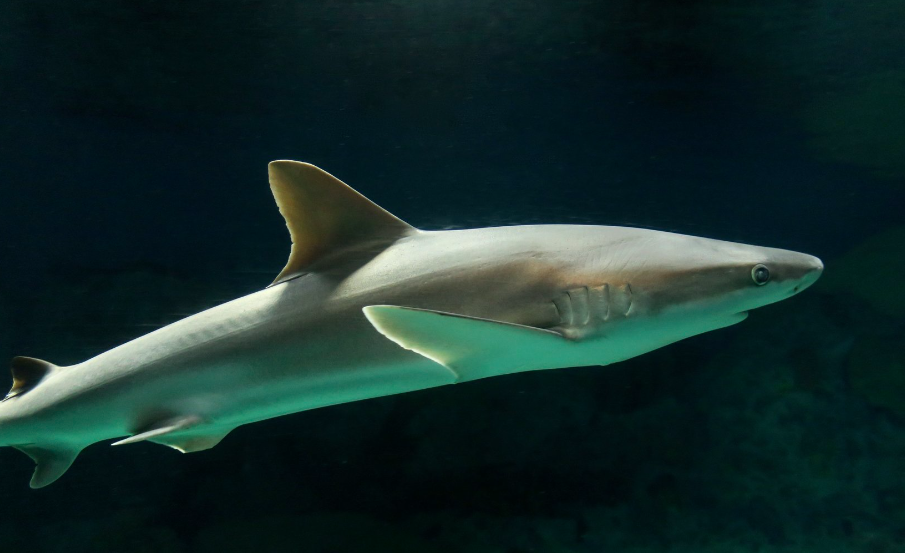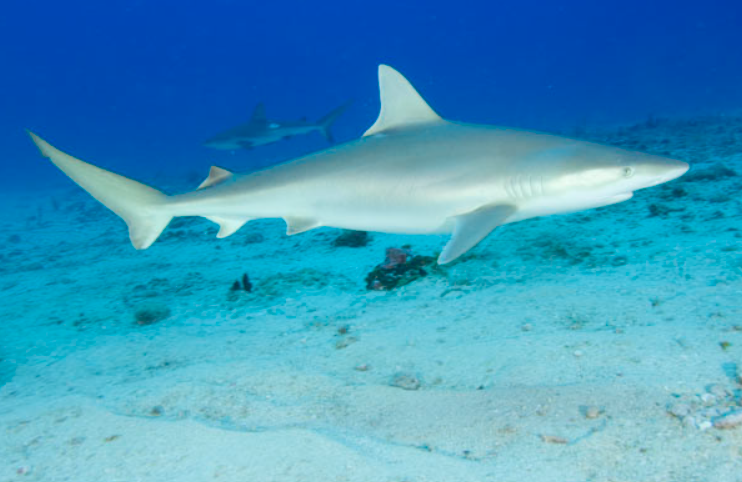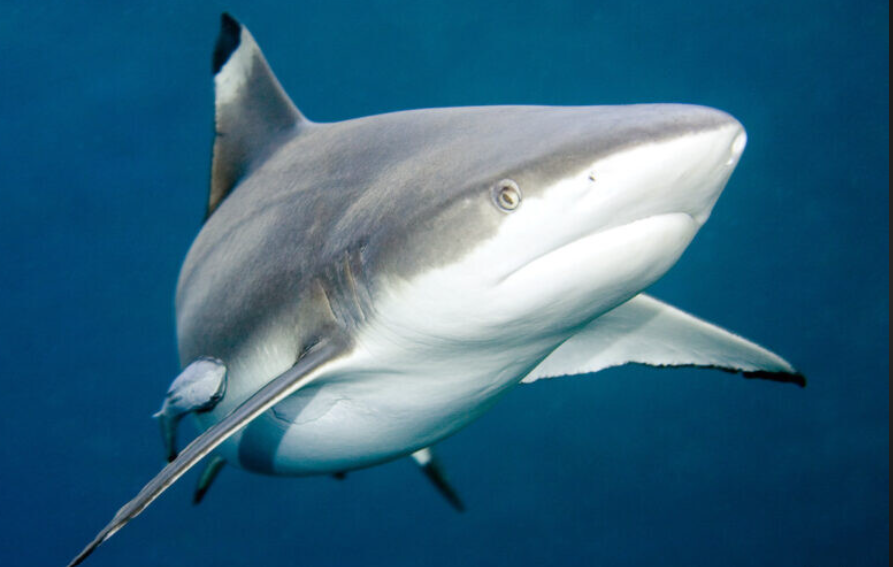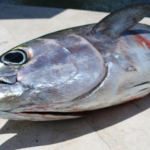Quick Top 10 Facts about Blacknose Shark Fish
| SCIENTIFIC NAME | Carcharhinus acronotus |
| CLASSIFICATION |
KINGDOM: Animalia CLASS: Chondrichthyes ORDER: Carcharhiniformes FAMILY: Carcharhinidae PHYLUM: Chordata GENUS: Carcharhinus |
| SIZE | Typically around 1.2 meters (4 feet) in length, but can grow up to 1.5 meters (5 feet) |
| HABITAT | Inhabits shallow coastal waters, usually in the Gulf of Mexico, the western Atlantic, and the Caribbean Sea |
| DIET | Carnivorous – primarily feeds on small fish, invertebrates, and crustaceans |
| SPECIES | Blacknose shark (Carcharhinus acronotus), also known as the small tooth blacknose shark |
| COUNTRY | Found primarily in the waters of the Gulf of Mexico, western Atlantic Ocean, and the Caribbean Sea |
| GESTATION PERIOD | Gestation lasts about 10–12 months, giving birth to live young |
| LIFE SPAN | Can live for up to 15 years or more in the wild |
| CONSERVATION STATUS | Not currently listed as endangered, but population is affected by overfishing and habitat degradation |
Amazing Facts About Blacknose Shark Fish
1. Recognizable black markings
The Blacknose Shark is easily recognizable by the distinctive black markings around its nose and dorsal fin.
2. Prefers shallow waters
These sharks are usually found in shallow coastal waters, often in sandy or muddy bottoms near reefs and estuaries.
3. Agile hunters
Blacknose sharks are known for their speed and agility while hunting for smaller fish, crabs, and other marine life.
4. Not typically dangerous to humans
While they are predatory, Blacknose sharks are not considered dangerous to humans due to their small size and non-aggressive nature.
5. Give birth to live young
Blacknose sharks are viviparous, meaning they give birth to live young after a lengthy gestation period of 10-12 months.
6. Adaptable to varying habitats
While typically found in coastal areas, Blacknose sharks can adapt to a range of environments, including deeper waters.
7. Active predators at night
Like many sharks, Blacknose sharks tend to be more active at night, hunting and foraging for food during the evening hours.
8. Play a role in marine ecosystems
As apex predators, Blacknose sharks help maintain the balance of marine ecosystems by controlling the populations of smaller fish and invertebrates.
9. Social and often found in groups
Blacknose sharks are social animals and are often seen swimming in groups or schools, particularly during the mating season.
10. Threatened by human activities
Like many shark species, Blacknose sharks are vulnerable to overfishing, habitat destruction, and the impacts of climate change, making conservation efforts crucial for their future.
Intriguing facts about the blacknose shark
In the western Atlantic Ocean, there exists a species of requiem shark known as the blacknose shark. Its scientific name, Carcharhinus acronotus, is another name for it. Its name is derived from a black spot on the tip of its nose, which is responsible for its unusual appearance. This species is found in shallow coastal regions, including bays, estuaries, and coral reefs, and it is dispersed from North Carolina to Brazil.
Body and Appearance of blacknose shark
The amazing blacknose shark has evolved to live well in coastal environments. It’s a fascinating shark to watch with its characteristic black nose and slim body. We may recognise the special properties of the blacknose shark and try to conserve it by learning more about its physical attributes, habitat, food, and reproductive activities.
Description of physical characteristics of the Blacknose Shark
Blacknose sharks are a very small species, with an average adult length of 4.5 feet. On a slender frame, they feature large, round eyes and a long, pointed nose. Although this varies depending on their age and region, they often have a lighter tint on their bottom and a greyish-brown or golden colour on their upper body.
Diet and Feeding Habits of Blacknose Shark
These sharks are nocturnal hunters that focus mostly on small fish, crabs, and cephalopods. Their sharp, serrated teeth are perfect for snaring and eating their prey. Although they are predators, blacknose sharks are generally considered harmless and not a threat to humans.
Reproduction and Life Cycle of Blacknose shark
Blacknose shark reproduction is an amazing and unique process. They are viviparous, which means that the growing embryos within the mother’s body get sustenance from the placenta. After a gestation period of around 10 months, the female gives birth to live young; typically, a litter of 4 to 7 puppies is born. These pups weigh between sixteen and twenty inches at birth, making them fairly large.
Fascinating facts about Blacknose Shark
Fascinating blacknose shark species are found in the western Atlantic Ocean. It is easily recognised because of its slender build and distinctive black marking on its snout. Despite being a nocturnal predator, it poses no significant threat to humans. It is further distinguished by its viviparous reproductive behaviour, which yields live progeny. Learning about blacknose sharks improves our understanding of them and contributes to the preservation of marine environments.

Preferred habitat of Blacknose Sharks
The western Atlantic Ocean, extending from North Carolina to Brazil, is home to the blacknose shark (Carcharhinus acronotus). It is a fairly tiny shark with characteristic black markings on its snout, usually reaching a length of 3 to 4 feet.
blacknose shark has distinctive features, such as its black nose and dark markings on its snout
One of the blacknose shark, which juts out between its eyes, is one of its most distinctive characteristics. The shark’s name derives from its distinctive marking. With a white belly, the remainder of its body is usually light grey or brown in colour.
How Blacknose shark body is adapted for efficient movement
Blacknose sharks can swim swiftly and effectively because of their slim body type and streamlined appearance. They have two dorsal fins, with the bigger and more triangular-shaped one on top. They also have somewhat long and slender pectoral fins.
The Blacknose Shark’s dental structure
Blacknose sharks have many rows of teeth that are continuously replaced during their lives, much like other shark species. Their teeth are keen and serrated, making them ideal for snaring and devouring their prey.
Specific regions where they are commonly found
The majority of blacknose shark habitat is located in coastal waters, which includes nearshore regions, bays, and estuaries. They are often found close to coral reefs and other underwater structures, and they favour shallow areas with muddy or sandy bottoms.
Habitat and distribution of blacknose shark
The western Atlantic Ocean, which stretches from North Carolina to Brazil, is where these sharks are most often seen. They may also occasionally be seen in the Caribbean Sea and the Gulf of Mexico. It is well known that blacknose sharks migrate seasonally, travelling south in the winter and north in the summer.
Hunting and defence mechanisms of Blacknose Sharks
As opportunistic hunters, blacknose sharks consume a wide range of tiny fish, crustaceans, and cephalopods. The main foods they eat include species like prawns, menhaden, mullet, and anchovies. These sharks detect prey using their keen sense of smell, as is well known. They will swim swiftly in the direction of any possible food, locate it, then use their pointed teeth to seize and devour it. Although they usually hunt alone, blacknose sharks sometimes gather in small groups to share prey.
Gestation period and birth of pups of Blacknose Sharks
The gestation cycle of blacknose sharks is rather brief, lasting around 10 months. The female will give birth to live offspring, referred to as pups, after mating. Although it might vary, a litter usually consists of two to six puppies.
Information on the growth rate and lifespan of the Blacknose Sharks
The puppies are allowed to fend for themselves as soon as they are born. Their rapid growth allows them to attain sexual maturity between the ages of two and three. A blacknose shark’s lifetime is thought to be between 12 and 15 years.
Conservation efforts to ensure blacknose shark survival
The International Union for Conservation of Nature presently lists the blacknose shark as a species of least concern (IUCN). Although they are sometimes taken as bycatch in commercial fishing operations, there is no reason to believe that their number is in danger of drastically declining.

Habitat preservation for blacknose shark survival
But it’s vital to remember that habitat preservation and sustainable fishing methods are essential to the long-term survival of all shark species, including blacknose sharks. We can make sure that these amazing animals are still in our waters by putting policies in place to reduce bycatch and preserve their habitats.
FAQ (Frequently Asked Questions) about Blacknose Shark Fish
Q: What is a Blacknose Shark Fish?
Ans: The Blacknose Shark, scientifically known as Carcharhinus acronotus, is a species of requiem shark found in the western Atlantic Ocean. It is named for the black marking at the tip of its nose, which gives it a distinct appearance. Despite its name, it is actually a type of small shark rather than a true “shark” like its larger relatives.
Q: Why is it called the Blacknose Shark?
Ans: The Blacknose Shark is named after the dark, blackish coloration at the tip of its snout. This characteristic is one of the most noticeable features of the species, making it easy to identify in the wild.
Q: Where does the Blacknose Shark Fish live?
Ans: The Blacknose Shark is found in warm coastal waters along the eastern United States, the Gulf of Mexico, and the Caribbean Sea. It typically inhabits shallow waters, including estuaries, bays, and reef areas, but it can also venture into deeper offshore waters.
Q: What does the Blacknose Shark Fish eat?
Ans: Blacknose Sharks are carnivorous, feeding on a variety of small fish, crustaceans, and invertebrates. They are opportunistic feeders and may also hunt small cephalopods such as squids.
Q: Is the Blacknose Shark Fish dangerous?
Ans: While the Blacknose Shark has a shark-like appearance, it is generally not considered dangerous to humans. It is a relatively small and non-aggressive species, and it typically poses no threat unless provoked.
Q: How big does the Blacknose Shark Fish get?
Ans: The Blacknose Shark is a small shark species, growing to a maximum length of around 4 feet (1.2 meters). Most individuals, however, typically reach lengths between 2.5 to 3 feet (0.76 to 0.91 meters).
Q: How does the Blacknose Shark Fish behave?
Ans: The Blacknose Shark is generally active and can be found swimming in schools or alone. It is a fast swimmer, often seen patrolling shallow coastal waters. This species is known for its inquisitive nature and its tendency to forage for food along the seafloor.
Q: Can the Blacknose Shark Fish be kept in aquariums?
Ans: Due to their size and active nature, Blacknose Sharks are not typically kept in home aquariums. They require large, well-maintained tanks with plenty of space to swim. Additionally, they need specific water conditions, such as saltwater, to thrive.
Q: How long do Blacknose Sharks live?
Ans: The Blacknose Shark has a relatively long lifespan for a small shark species, typically living for around 10 to 12 years in the wild. Proper care in captivity, such as maintaining clean water and appropriate diet, can extend their lifespan.
Q: Are Blacknose Shark Fish rare?
Ans: Blacknose Sharks are not considered rare, but they are classified as “Near Threatened” by the International Union for Conservation of Nature (IUCN) due to habitat loss and overfishing. They are not often encountered by recreational divers due to their preference for shallow waters near the coastline.
#BlacknoseShark, #SharkFish, #RequiemSharks, #CoastalSharks, #MarineLife, #SaltwaterFish, #SharkSpecies, #OceanLife, #SharksOfTheSea, #AquariumSharks, #MarineConservation, #SharkResearch
Our sources and references about Blacknose Shark Fish
1: IUCN Red List – Blacknose Shark
2: NOAA Fisheries – Blacknose Shark
3: Sharksider – Blacknose Shark Overview
4: Aquarium Fish – Blacknose Shark


